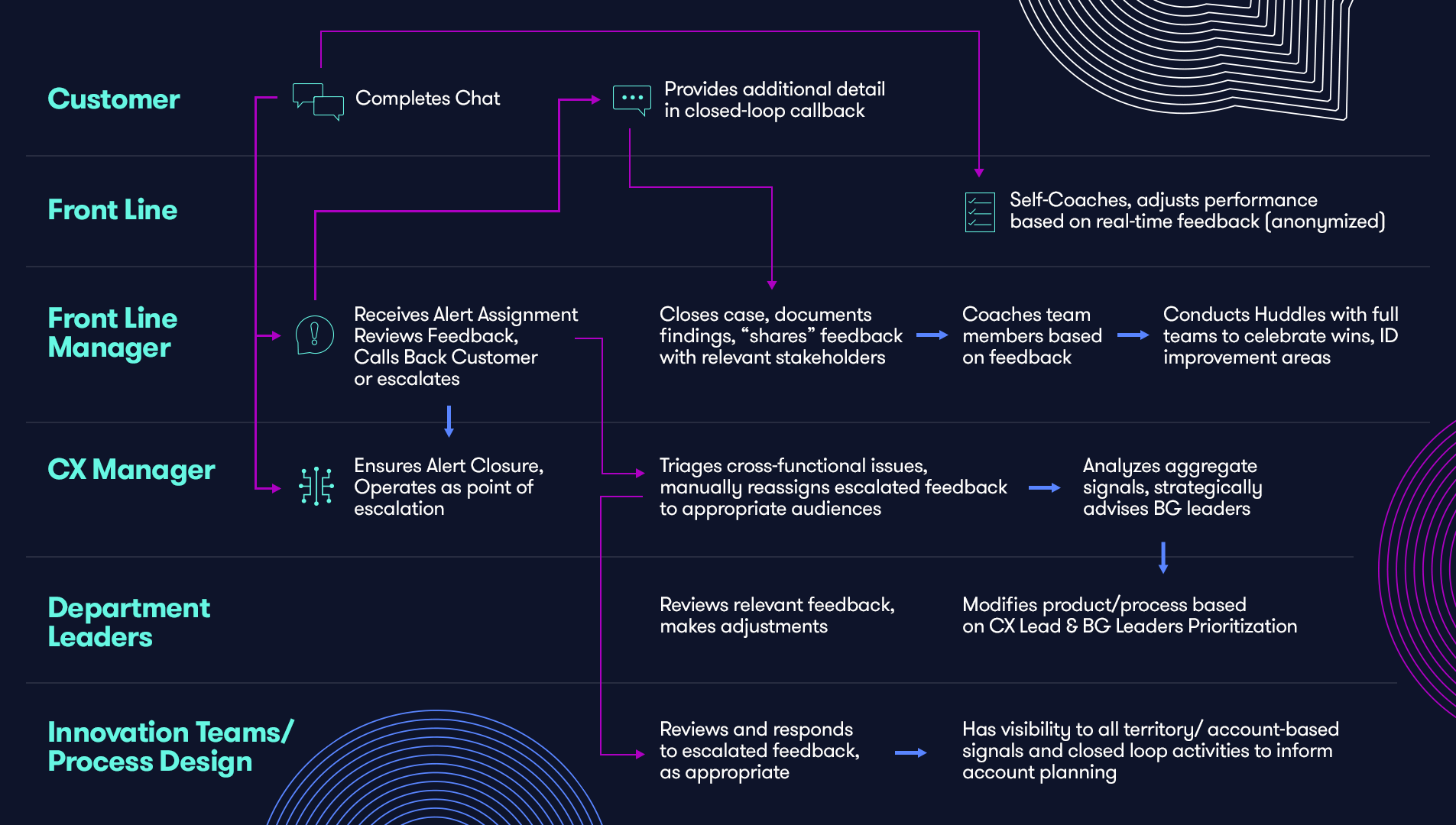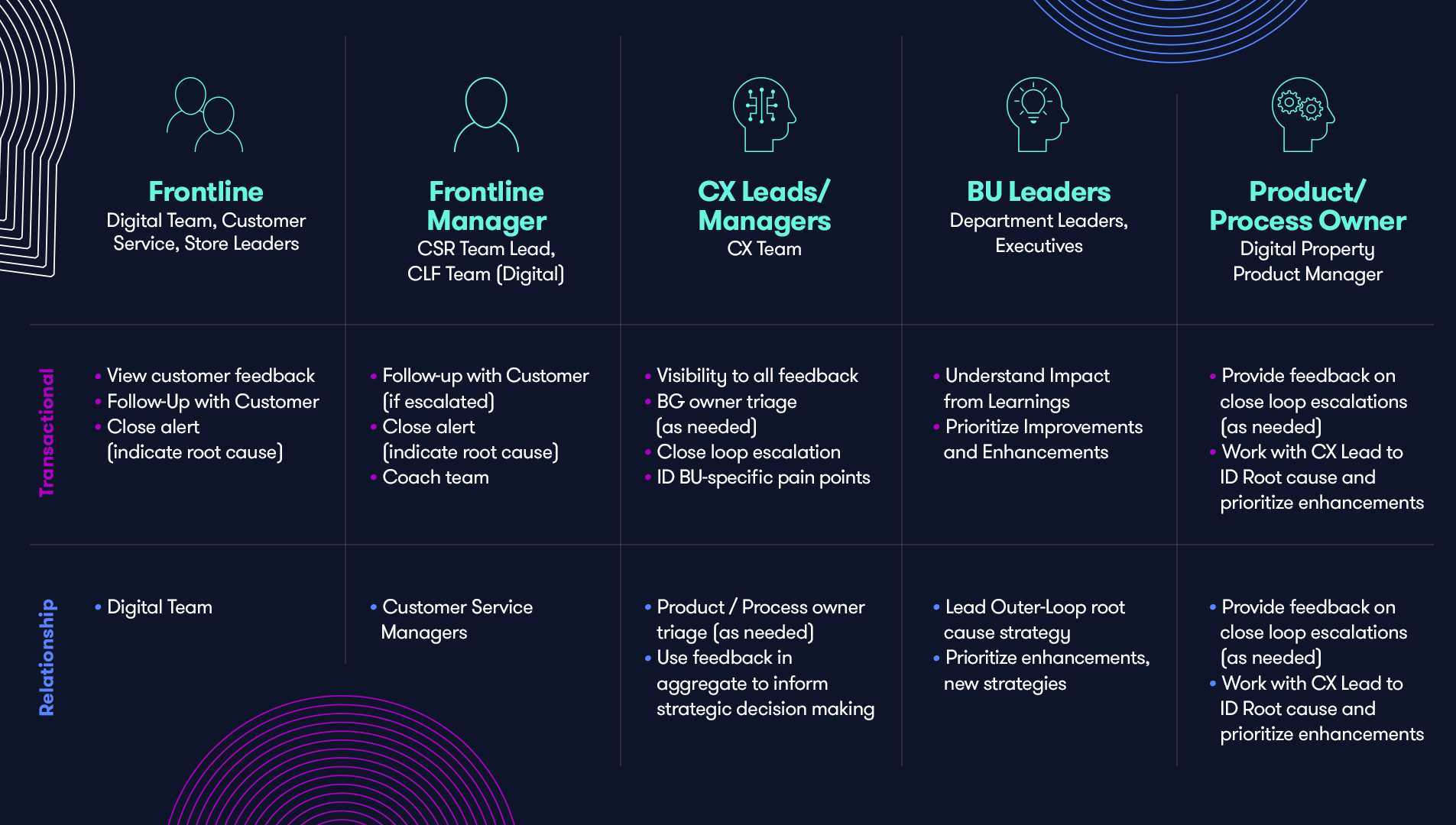BLOG
Why organizations should activate every employee with closed-loop feedback (Part 2 of 2)

A few weeks ago, I purchased a pair of sneakers from one of my favorite sportswear brands. Upon delivery, I noticed the box was significantly damaged including a very soggy box corner. Ultimately, the water damage caused the leather dye to discolor the white shoe laces. A few hours later, I received email requesting feedback regarding my purchase. My CSAT score was a 3 and I explained in the comment box why I rated my satisfaction low.
Within 30-minutes of submitting my feedback, I received a closed the loop phone call from the brand. The brand wanted to reassure me they were sincerely sorry for the condition the shoes appeared and offered to overnight a new pair of shoes. The process was very convenient as well as the return process of the original shipment.
This is a shining example of taking action and closing the loop. The brand invested the time to understand my frustration, resolve the issue and recover my loyalty. Additionally, the trust I have in the brand to resolve an issue if I experience one in the future has significantly increased which means I will continue to purchase from this brand (my CLTV will continue to increase).
In the first part of this blog, I shared an experience I had as a consumer interacting with a global coffee chain. This experience was the motivation to write this series.
I also shared the foundational approach to taking action with Closing the Loop – both inner and outer loops. I defined closing the loop, who is responsible for closing the loop and the data driven evidence to why closing the loop is important.
For part two, I will help connect the dots on measuring the impact of closing the loop, understanding the different close–the–loop alert triggers, and sharing a guide for how brands can launch a strategy of their own (or improve their current approach).
How to close the customer feedback loop
Must-have alerts in your loop closure toolbox
Score Alert – the most common close loop action alert. When a customer selects a low rating on the NPS, CSAT or OSAT survey question, this would create an alert for an employee to follow-up with the customer regarding their experience with the brand. As brands mature their close loop strategy, they begin to trigger for passives and promoters (NPS segments) to enrich the customer relationships, ask for referrals or cross-sell additional products or services.
Topic Alert – When a customer provides feedback in an open comment box, brands need the capability to route and empower the correct department functions to close the loop with the customer. For example, a customer might have had a great in-store experience with the brand and selected a 9 or 10 on the NPS scale, but provided feedback in the improvement section on product quality. In this example, the score alert would not be triggered, but the brand misses a prime opportunity to connect with the customer. Additional common topic alerts would be charges, fees, inventory, delivery and shipping, future product interests, and purchase intent.
Risk Alert – This alert is the most mature of all alerts. Essentially, brands should aspire to understand the entire customer journey leveraging all customer data (feedback – solicited and unsolicited, transactional and behavioral) to build a risk profile to predict future churn as an example in order to proactively recover and build the relationship prior to the customer churning versus being reactive after the customer has churned.
From a design perspective, how should we be thinking about the inner and outer loop to maximize efficiency?
Teams should be designing systems to enable the inner and outer loop to act at scale and in an agile approach. Too often, brands will design for the inner loop and fail to design for frontline employee coaching and operational process improvement. Thus, the customer relationship may get resolved, but due to a lack of operational process improvement, thousands of other customers are impacted creating a never-ending cycle.
Below is an example design of a high-functioning inner and outer loop system. In this example, the brand leveraged their experience technology to automate the different alert types to the appropriate teams to take action closing the outer loop.
Inner & outer loop action design example

Which key team players should be involved in the closed-loop system?
The inner and outer loop system involves both transactional and relationship driven loops. Each key team player will have responsibility across the loops to directly close the loop with customers and cross-functionally work in teams to improve processes and innovation.
Inner & outer loop system key team players

How should you measure the impact of your closed-loop system?
Understanding the effectiveness of your close loop system is important to effectively maximize operational processes, grow customer base and reduce customer churn. Measuring your CTL process also enables your executive team to prioritize top initiatives within the business strategy while maximizing funding for key initiatives.
There are 4 common close the loop system business impacts that should be measured:
1.) Time to Resolution – most commonly measured by the number of contact attempts (outbound calls, email, SMS and/or social) made to connect with the customer as well as the total amount of time spent within the specific close loop case. The key to measuring time to resolution is utilizing supporting data like communication channel, number of outbound attempts, and actual time to resolution.
2.) Resolution Satisfaction – a post follow-up chat with the customer to understand their satisfaction (CSAT) with the employee’s attempt to resolve the issues or poor experience. It is important to note it does not measure the satisfaction of the actual resolution given frontline employees are not always empowered to waive fees as an example. Sentiment analysis can also be used to further understand overall satisfaction.
3.) Cost of Service – many brands focus on #1 and #2 without measuring the actual financial impact of resolving poor experiences. What are the financial considerations (discounts, refunds, cost to re-ship, etc.) the brand has to make in order to resolve the issue and recover the customer relationship? Additionally, how much time do employees spend on closing the inner loop, and what is the cost for that employee (average hourly rate X time to resolve)? Brands can utilize transactional data and HRIS data to calculate the Cost of Service.
4.) Trailing Financial Impact – just like the cost-of-service impact, the trailing financial impact is seldom utilized to understand the closed loop system financial impact. By understanding trailing financial impact (time to repeat purchase, total # of purchases, total and average spend $, and marketing engagements like opens and opt-outs) during a specific trailing time period like 6 or 12 months, you can clearly understand if the customer relationship was recovered effectively.
Additional Frequently Asked Questions we receive when designing a closed loop system:
Should I offer monetary compensation to recover the customer relationship?
Chatter analyzed more than 500,000 close loop alert cases to understand the impact of offering monetary compensation at 15 different retail brands. The analysis showed that 84% of customers that were successfully contacted and offered monetary compensation during the close loop process made an additional purchase with the brand within the trailing 3-months post resolution. On the flip side, only 52% of customers who were not successfully contacted made an additional purchase with the brand within the trailing 3-month post alert creation.
How quickly should our team close the loop with customers after receiving the alert?
The goal should always be to close the loop as quickly as possible after the alert is created. This focused action reassures the customer their relationship is more than just transactional and it re-establishes the trust between brand and customer. During the same analysis of 500,000 close loop alert cases at 15 different retail brands, the data proved when a customer was contacted within 24 hours of the alert creation, the customer had an increase of 4.5% in the trailing 4 months. Conversely, if the first contact attempt was greater than 24 hours post alert creation, the 4-month trailing spend decreased by 2%.
When designing your close loop system, it is important to have a well-defined process that empowers the right key players, measures impact and most importantly, re-establishes trust with the customer.
Not sure where to start? Chatter’s closed-loop tool is a turnkey solution for saving relationships and boosting your bottom line.